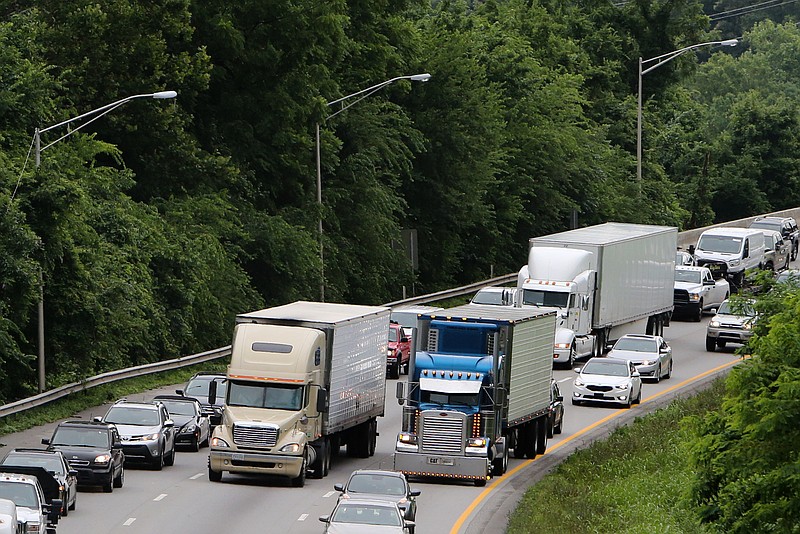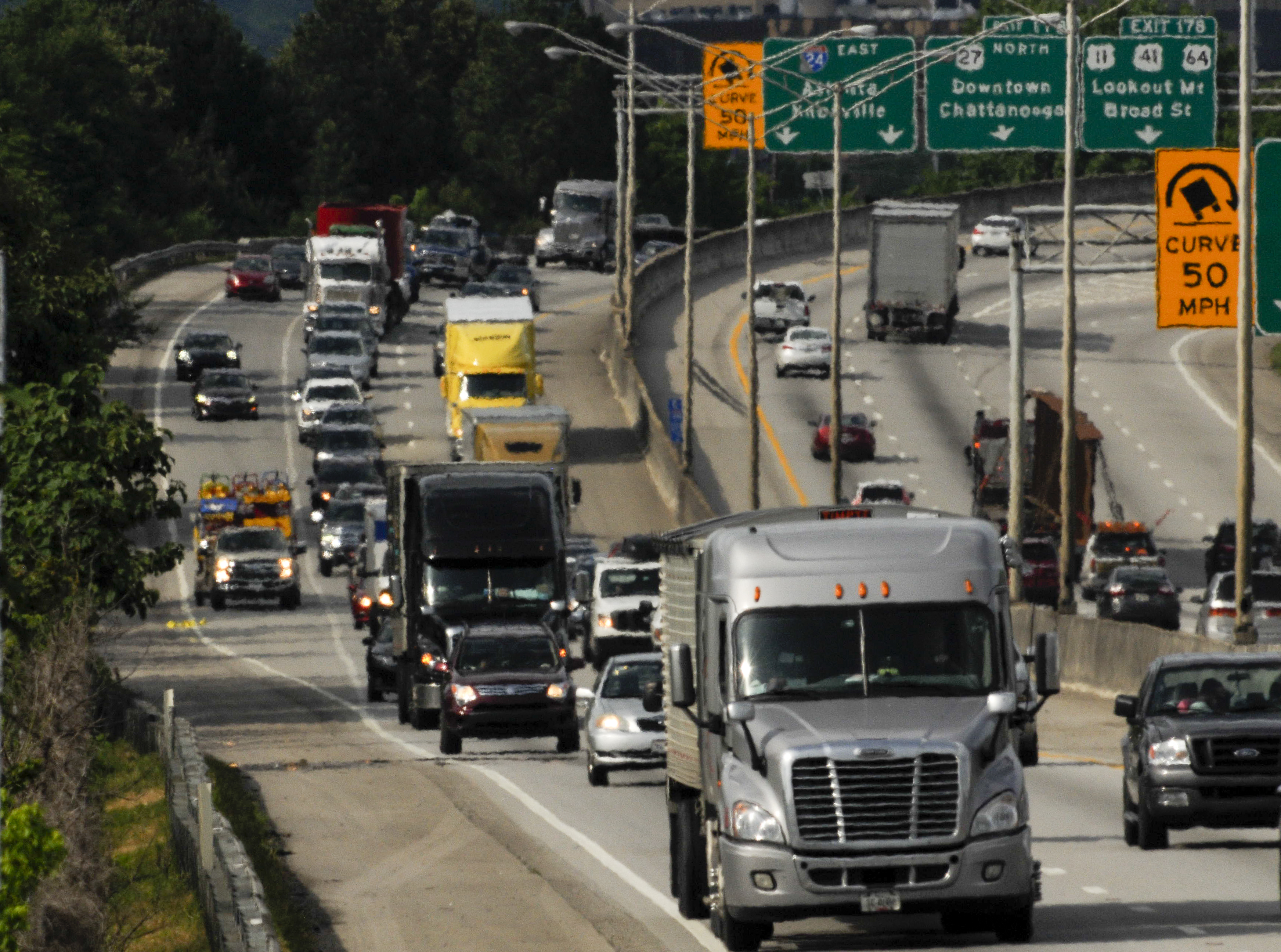Chattanoogans love their cars, and it's becoming a bit of a problem for the region.
Rush hour on Interstate 24 at the ridge cut on any given week day can make or break a commuter's estimated time of arrival.
Even a minor crash pushed to the shoulder is enough to bring traffic to a halt while major collisions or bad weather can hold up commuters for hours. Bosses and daycare workers usually don't appreciate the excuse of "bad timing" when it comes to missed meetings or late pickups.
Unfortunately, it could get worse, which is why some local leaders are starting to explore how Chattanoogans can get to work differently in the future with ideas such as improving mass transit to working from home and any other options that get more people off the highway. For good reason, too. It would save everyone a lot of money.
Forty-four percent of those employed in Hamilton County commute from outside of the county, 120,000 vehicles were estimated to travel through downtown Chattanooga each day on Interstate 24 in 2016 and 33 million tons of freight is expected to travel through the Chattanooga area per year by 2035 - up from 25 million tons, according to data provided by Thrive Regional Partnership. Estimates show that by 2040, nearly 1.4 million people will call the greater Chattanooga area home.
All of that sounds really good for the economy but really bad for the existing roads, officials say. The I-24/U.S. Highway 27 interchange has already been ranked the 11th worst freight gridlock in America and the first in the state of Tennessee, according to the American Transportation Research Institute.
Making roads bigger will take years and funds that could be used elsewhere if Thrive officials and other area agencies and business leaders can convince more people to find alternative ways to get to work. When it comes to workforce mobility in the future, members of a year-long "Transportation Collaborative" provided recommendations, including building a digital platform to access information on all modes of mobility such as mass transit, walking, biking and car-sharing solutions; creating an app that tells drivers what backroads to take instead of the interstate; more employers providing telecommuting options, or creating a network of co-working centers across the region to share resources and function as work spaces.
"We talk about congestion at peak times of the day ... we talk about spending millions, billions of dollars to fix that instead of talking about the behavior patterns of the people that are using that infrastructure during the peak times of day and what we can do now instead of waiting years for millions or billions of dollars to be spent," said Thrive President and CEO Bridgett Massengill.
"What is life going to be like 20 years down the road?" she asked. "Let's start looking at the behavior patterns that can hopefully help to alleviate some of this and save our public dollars a tremendous amount by just keeping up with the future of the workforce."
The collaborative was convened by Thrive and consisted of more than 30 local business leaders and public officials from Alabama, Tennessee and Georgia. Members are a part of city and county governments, development agencies, industries, like trucking and logistics, food, health care and more. Thrive is a nonprofit focused on promoting responsible growth for the next 40 years through the tri-state Chattanooga region, which includes working with 16 counties in three different states and three different metropolitan planning organizations - no small feat.
The approach requires looking at the "big picture," Massengill explains. But in Hamilton County - where the public transportation ridership for commuters is only at 1 percent and nearly 83 percent of commuters drive solo to work, according to U.S. Census Bureau figures - convincing employees and employers could be difficult.
Dan Pallme sees the traffic back up on Nashville streets from where he lives in a downtown highrise. Pallme works for the Tennessee Department of Transportation and is the assistant chief of environment and planning and director of the Freight and Logistics Division. He acts as an industry liasion with part of his job dedicated to looking at how the increased freight traffic in the future will impact the state and areas such as Chattanooga.
"It's really something that's on my radar ... you can't just keep making interstates wider, wider and wider because there's no land and it affects quality of life," he said. "You've got some topography issues in Chattanooga, as well. Companies, shippers, carriers and the public have all got to rethink how we do it."
The U.S. Highway 27 project through downtown Chattanooga is a model example. Tagged as the most expensive Tennessee Department of Transportation project of its kind in the state's history, the cost of the widening project has jumped more than 13 percent from the original $126 million bid to an estimated $143 million and will take a year longer to complete than estimated, the state agency reports. Funding to pay for the rising cost is borne by the state and federal governments.
Pallme acknowledges that it's hard to get people get out of their cars in the South, and that it's not a problem unique to Chattanooga. In places like New York City or Washington D.C., people can pay exorbitant fees to have their own car, which is why public transit is much more popular.
The TDOT official has looked at ideas across the country, like how trucking companies could put drivers on the road overnight so they aren't delivering in peak travel times or how electric vehicles may minimize environmental impacts that increased commuter traffic can cause.
"The congestion is bad here, but in New York City it's outrageous," Pallme said. "At some point, people have to feel pain, and I don't think we are there yet."
CARTA'S CHICKEN AND THE EGG
The Chattanooga Area Regional Transportation Authority has a $22.5 million budget for the 2018-2019 fiscal year with roughly $5.5 million coming from local sources. CARTA figures show that last fiscal year, there were 2.7 million trips - not passengers - completed.
CARTA operates more than just their 17 fixed-route bus system, though. They also provide specialized transportation for the disabled through their Care-a-van program and operate the downtown electric shuttle system, which is free to passengers, among other things.
While more than 2.5 million trips sounds like a lot, census figures still show only about 1 percent of commuters over the age of 16 use public transit in Hamilton County. So, why don't more people rely on mass transit? Well, some parts of the city are much easier to reach than others.
Angelo Burris, a student at Chattanooga State Community College, says it takes him two hours each way to ride the bus to the school off Amnicola Highway from the bus stop at Brainerd and Germantown roads. He said he commutes two days a week, four hours each day, to get to and from classes.
On the 7:50 a.m. bus on route 4 that Burris rides on Wednesdays, Jason Hillis sat a few seats back with his headphones in, listening to music. The 45-year-old works as a laboratory technician at a business off Rossville Boulevard, and it takes him around 40 minutes to get to work each day from the Brainerd and Germantown roads bus stop. He first takes the bus on route 4 before getting off and transferring to another bus downtown on Market Street that takes him to his final destination.
"If you know how to work it and you are patient then you can get around," he said.
Hillis said he has his license, but it's cheaper and more affordable for him to take the bus everywhere, including grocery shopping and for social activities.
"That's money I can spend other things on," he said.
The personal finance website NerdWallet reports that for vehicles driven 15,000 miles a year, the average car ownership costs were $8,469 per year in 2017, or about $706 a month. That's for someone with a monthly car payment of $523, though. For those with no monthly car payment, the cost would still be over $2,000 a year, according to those figures.
A monthly bus pass from CARTA costs $50 for unlimited rides, or $600 a year.
CARTA Executive Director Lisa Maragnano said the year-long redesign study the agency is conducting in partnership with the city and the Chattanooga-Hamilton County Regional Planning Agency should help increase use on some of the fixed routes or create new ones based on residents' needs and wants.
Thanks to a three-year pilot program, direct rides from downtown out to the Enterprise South industrial park where Volkswagen and Amazon are located are available for employees of two of the largest employers in town. With the news that Volkswagen will be expanding and adding 1,000 new jobs in the area, Maragnano said CARTA will have to accommodate.
"With that expansion, there's not enough infrastructure out there to handle everything," she said. "We hope we can help some of the businesses incentivize employees to use transit passes and help these businesses and folks use the service more."
It's difficult knowing what should improve first, though. Should CARTA improve their current system or try and recruit more riders first? It's hard to get the funding when the ridership isn't there. It's a classic dilemma often contextualized by the argument, "Which came first: the chicken or the egg?"
Massengill says she sees a strong collaboration in the future between Thrive and GreenTrips and other transit-based apps that people can use to find the quickest alternative forms of transportation. GreenTrips is a project of the regional planning agency that encourages commuters to find other ways to get to work - from taking public transit to riding a bike or carpooling with others. For every trip completed that a commuter doesn't drive alone, they get rewards that can be redeemed at local restaurants and other businesses.
"If we can get people more educated on the positives and what it looks like to have a good, strong public transportation, which is what we are working toward, then we can get people thinking outside of the box in Chattanooga," Maragnano said.
20-MINUTE TOWN
Currently, a driver could get from north of the Tennessee River downtown to Hamilton Place Mall in about 20 minutes or less during non-peak travel times in Chattanooga. Despite the estimated 1.4 million people who will call the greater Chattanooga region home by 2040, local officials have set a goal to keep it that way amid the growth.
Velocity 2040, a community visioning process, outlines several adjustments Chattanooga and Hamilton County needs to make in order to ensure people can get where they need to go in 20 minutes or less 20 years from now. Ideas include large employers adjusting the times employees start and end each work day; subsidizing employee's mass transit and bus fare, experimenting with ride-sharing and employers providing on-site child care for parents.
All of these suggestions mean nothing unless companies are willing to experiment, officials say. Twenty years from now, there may be autonomous vehicles and advances in technology that are inconceivable today, but people will still need to earn a living. It's about changing perceptions, Massengill alleges.
"There's a lot of advantages as to why we would test it, push it and help it along," she said. "I would like to see us be a leader in the Southeast for a different way of tackling traditional transportation infrastructure problems."
And it's not just to benefit those who live here, Massengill explained. People visit Chattanooga and move here because of the quality of life.
"It's important for us to figure out," she said. "So that we can preserve the beauty of this region that we know is a huge driver for why people visit here, move here and stay here."
Contact staff writer Allison Shirk Collins at ashirk@timesfreepress.com, @AllisonSCollins or 423-757-6651.

